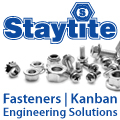
Posted to News on 2nd Jul 2024, 10:15
Ultrasonic Welding Technology Enhances Manufacturing Processes
Martin Frost, recently retired from his position of UK Sales Manager at Telsonic, and with the benefit of 28 years of experience, summarises the contribution which ultrasonic technology has made to manufacturing processes and looks at the new ultrasonic processes and technology developments which have opened up new application areas.

The use of thermo-plastics has been with us for some time and has continued to expand as a result of ongoing material development and innovative plastic processing techniques that together have enhanced and expanded the range of applications for these materials. This in turn has opened up new opportunities for the use of Ultrasonic technology for plastics welding applications.
Although plastics are used across multiple market sectors, the quest for improved performance, weight reduction, recyclability, and cost reductions within dynamic sectors such as automotive and packaging have been key drivers behind the increased use of ultrasonic technology. The ultrasonic weld process is now increasingly replacing mechanical fastening, heat, and adhesive joining technologies, providing both a cost effective and environmentally friendly solution.
The traditional ultrasonic method for welding plastics and some metals is the longitudinal process. However, as for many other joining methods, there are times when the process reaches it limits, perhaps in weld size, welding in restricted areas, with geometric shapes, or the effects of vibration on peripheral items such as membranes or some electrical / electronic components.
Developed by Telsonic, to address the few limitations of longitudinal welding, the torsional ultrasonic welding process, known as SONIQTWIST, quickly established itself as the preferred joining process for a wide range of plastics and metals. Using SONIQTWIST, torsional energy is gently delivered directly at the joint interface, making it suitable even for overly sensitive parts. This ability to successfully weld sensitive components, thin wall sections and join filters and membranes on medical components has significantly increased the adoption of the process within that sector.
Although suitable for delicate and sensitive parts, strong forces may still be applied over a very short time, which is a critical part of the process when for example, joining aluminium or copper cables. This ability to join copper and aluminium cables and terminals safely and securely has led to the Torsional SONIQTWIST process being adopted widely by companies manufacturing the cables and harnesses required for the expanding Electromobility sector.
The Torsional SONIQTWIST process makes a valuable contribution in weight reduction applications, battery packaging, cable to terminal connections, bus bars, battery manufacturing and power electronics.
The food sector has also benefited greatly from the introduction of ultrasonic technology for cutting and portioning applications. Factors driving what seems to be an ever-increasing demand for pre-portioned products in recent years include a greater tendency to eat-on-the-go, convenience for the consumer at home, time savings for retailers and the obvious hygiene benefits of foodstuffs being handled and portioned within a tightly controlled and clean environment.
The many benefits of the ultrasonic process, together with innovative automated production concepts such as robot mounted cutting blades, which can be up to 800mm wide, mean that a growing number of items such as sandwiches, cheesecake, gateaux, cheeses, meats, snack bars and a host of other products, are now being successfully cut and portioned automatically using this efficient and clean process.
A further influence in the uptake of the technology by many sectors has been its compatibility with the connectivity principles of Industry 4.0. Telsonic's bus module range, which can be integrated within the MAG generator range, and TelsoFlex press control software is used in both ultrasonic welding systems and automation lines, offering a full range of functions. The modular design of the software facilitates customisation whilst simultaneously future-proofing plastic welding, cut-and-seal, and metal welding applications.
As part of Telsonic digitalisation development, integrated welding control units for MAG generators provide local PLC weld control and feedback functionality at the generator allowing machine builders to arrange their own user interface configurations. The control includes actuator functions such as force cell and linear encoder function and tooling life cycle monitoring protocols.
Traceability is achieved through data acquisition and automatic welding logs. User and rights management functions ensure that only authorised personnel can make changes to system parameters and modern data interfaces make it possible to transfer data to customer MES systems (Manufacturing Execution Systems). The uptake of Bus systems and the ease of use allows machine builders more open-ended options in control and feedback functionality, based upon the scope, size and complexity of their machine. The addition of such functions, with no added cost and real time instruction enhances both calibration and diagnostic functions.
It is clear that ultrasonic technology has made some significant advances over the past few decades in terms of the new processing techniques which in turn have opened the door to new applications across a greater range of industry sectors. Ultrasonic processing is now firmly established within many manufacturers as the process of choice for plastic welding, metal welding, cutting, cut'n'seal, food portioning, packaging, sieving and cleaning. Ultrasonic welding is now also becoming a valuable asset in product development in combination with 3D printing technologies.
The recent enhancements in digitalisation and compatibility with industry 4.0 means that the use of this highly flexible technology will continue expand and it will be interesting to see where this technology goes next. One other interesting observation is that the use of basic hand-held ultrasonic technology for welding and joining is still as relevant today as it was when first launched almost 50 years ago.





